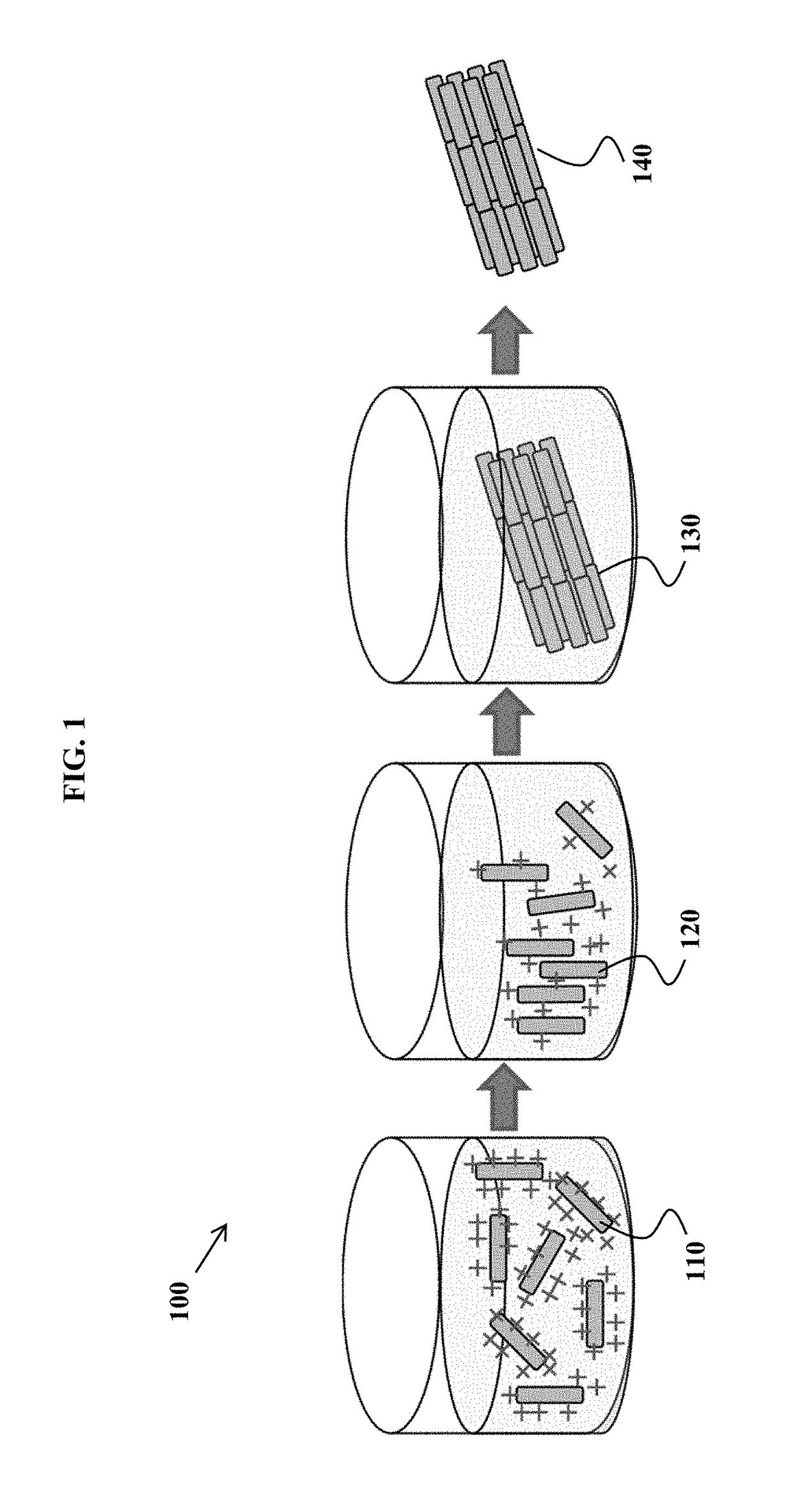Devices for charge-titrating particle assembly, and methods of using the devices
a charge-titration particle and particle technology, applied in the direction of polycrystalline material growth, after-treatment details, laboratory glassware, etc., can solve the problems of limiting durability, affecting the presence of organic ligands, and inhibiting electrical conductivity
- Summary
- Abstract
- Description
- Claims
- Application Information
AI Technical Summary
Benefits of technology
Problems solved by technology
Method used
Image
Examples
example 1
e Nanorods
[0234]In this example, β-FeOOH nanorods are fabricated for later assembly.
[0235]The synthesis of β-FeOOH nanorods occurs by mixing 270 mg of FeCl3.6H2O and 16 mL of water. The resulting transparent orange solution is then sealed in a Teflon-lined 23 mL acid digestion bomb that is subsequently warmed up at a rate of 1.0° C. / min to 120° C. and held for 1 hour in an oven. The reaction bomb is allowed to naturally cool down to room temperature after 1 hour and the resulting brown precipitate is collected with centrifugation. The solids are suspended in water, vortexed, and centrifuged; the supernatant is discarded. This cleaning step is repeated two additional times.
[0236]The material has an isoelectric point of 5.95. The iron oxide nanorods are shown in an SEM image, in FIG. 8.
example 2
ning Iron Oxide Nanorods
[0237]This example describes generation of aluminum-containing iron oxide nanorods for later assembly of the nanorods.
[0238]The synthesis of Al-containing β-FeOOH nanorods occurs by mixing 270 mg of FeCl3.6H2O, 120 mg urea, 43 mg of Al(NO3)3.9H2O, and 16 mL of water. The resulting transparent orange solution is then sealed in a Teflon-lined 23 mL acid digestion bomb that is subsequently warmed up at a rate of 1.0° C. / min to 120° C. and held for 2 hours in an oven. The reaction bomb is then allowed to naturally cool down to room temperature and the resulting brown precipitate is collected with centrifugation. The solids are suspended in water, vortexed, and centrifuged; the supernatant is discarded. This cleaning step is repeated two additional times.
[0239]The material has an isoelectric point of 7.50 showing that Al is present in the iron oxide (aluminum oxides have higher isoelectric points than iron oxides). The Al-containing β-FeOOH nanorods are shown in a...
example 3
of Iron Oxide Nanorods
[0240]In this example, the β-FeOOH nanorods fabricated in Example 1 are assembled into nanorod arrays.
[0241]The product from Example 1 is dispersed in 16 mL of deionized water. 8 mL of the material is separated and the pH is adjusted to 1.6 with 0.5 M HCl. 19 mg urea is added. The resulting suspension is then sealed in a Teflon-lined 23 mL acid digestion bomb that is subsequently warmed up at a rate of 1.0° C. / min to 120° C. and held for 1 hour in an oven. The reaction bomb is allowed to naturally cool down to room temperature.
[0242]The final pH is 6.70. The orange precipitate is collected with centrifugation. The solids are suspended in water, vortexed, and centrifuged; the supernatant is discarded. This cleaning step is repeated two additional times.
[0243]The assembled product is shown in a SEM image, in FIG. 10.
PUM
| Property | Measurement | Unit |
|---|---|---|
| particle size | aaaaa | aaaaa |
| particle size | aaaaa | aaaaa |
| zeta potential | aaaaa | aaaaa |
Abstract
Description
Claims
Application Information
 Login to View More
Login to View More - Generate Ideas
- Intellectual Property
- Life Sciences
- Materials
- Tech Scout
- Unparalleled Data Quality
- Higher Quality Content
- 60% Fewer Hallucinations
Browse by: Latest US Patents, China's latest patents, Technical Efficacy Thesaurus, Application Domain, Technology Topic, Popular Technical Reports.
© 2025 PatSnap. All rights reserved.Legal|Privacy policy|Modern Slavery Act Transparency Statement|Sitemap|About US| Contact US: help@patsnap.com



